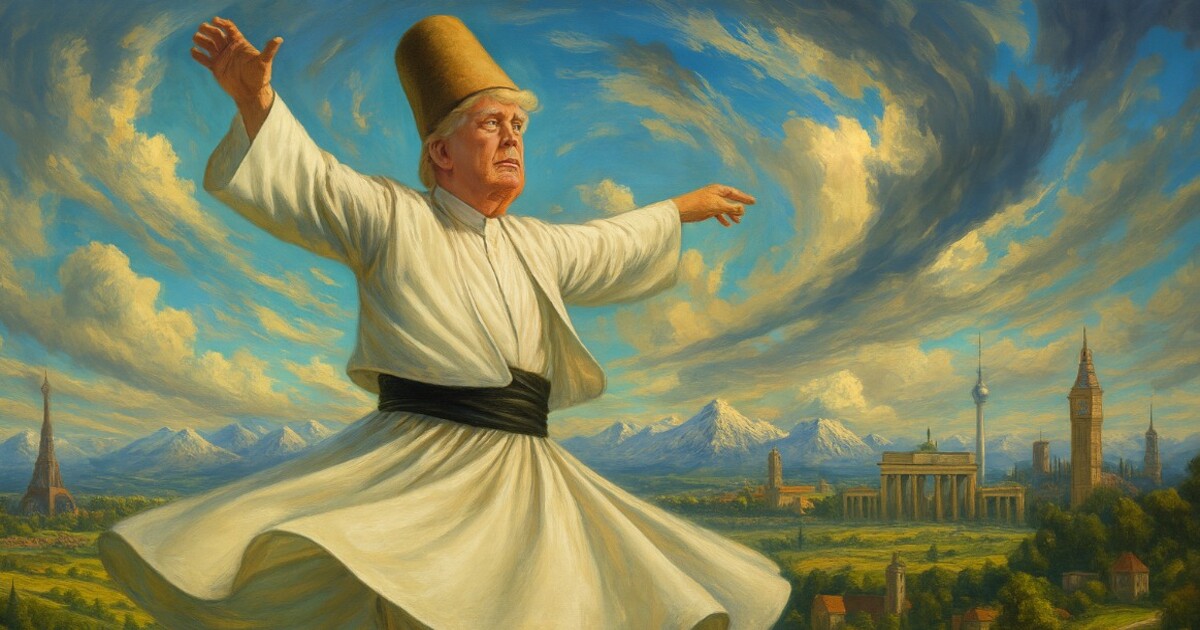A Century Apart, Two Disastrous Turns of U.S. Policy Toward Europe
Like Donald Trump now, U.S. leaders in the 1920s just wanted to wring money out of Europe. However, Donald Trump is also keen on completely rewriting the history of U.S.-European relations.
July 7, 2025

A Strategic Intervention Paper (SIP) from the Global Ideas Center
You may quote from this text, provided you mention the name of the author and reference it as a new Strategic Intervention Paper (SIP) published by the Global Ideas Center in Berlin on The Globalist.
With Donald Trump claiming that the “EU is far nastier than China,” it is high time to take a closer look at U.S.-European relations.
It turns out that, a century ago, in the early 1920s, the U.S. government focused on squeezing money out of European countries that had been its allies in the First World War. That narrow focus on money led to disaster.
Now, a century later, there is a U.S. President in office who pursues a similarly disastrous course toward Europe. Donald Trump claims that the EU was created after the Second World War to “rip off” the United States.
Whatever the spurious reasons he presents for his claim, with his tariff policy he is keen to wring money out of the United States’ long time allies — just as happened after the First World War.
Trump is not just after money, but reinterpreting history
This ominous parallel alone is enough reason for people in Europe and the United States who are understandably concerned that the United States under Trump has surrendered its role as the leader of the free world.
What makes the present episode even more ominous than the previous one is that Donald Trump is not just after money. His fixation is on reinterpreting the history of U.S.-EU relations in a completely distorted manner by claiming the United States has been deliberately victimized by the EU.
Even more troublingly, indications are that his doing so is yet another way in which he puts himself — and his nation — in the bizarre supporting role to serve Vladimir Putin’s narratives.
It happened before — a century ago
A century ago, after the end of the First World War, the U.S. government in the 1920s — under three consecutive Republican Presidents — suddenly began to focus on squeezing money out of the European countries that had been U.S. allies in the First World War.
During that bloody war from 1914 to 1918, American financiers had lent large sums to the Allies, principally to the British Empire. After the war, the U.S. government, led by its powerful Treasury Secretary Andrew Mellon, became their hard-charging debt collector.
The result, the financial collapse and the Great Depression, was a disaster for all. Ominously, Donald Trump — like U.S. Presidents Harding, Coolidge and Hoover during the 1920s — seems to be, in part, interested again in wringing money out of Europe.
Trump gets his post-Second World War history wrong
But Donald Trump goes much further than that. He has argued for decades that the EU was created after the Second World War to “rip off” the United States.
I know this is completely wrong. How so? Because, at the start of my career as a U.S. Foreign Service officer, I was assigned to European Affairs in the State Department from 1960 to 1962, working on European integration.
Back then, I saw close up how much U.S. leadership at the time wanted a united Europe. Indeed, in the early post-war decades, the U.S. government was a major — perhaps even the major — driving force behind promoting the cause of European integration.
No one thought the Europeans were trying to “rip us off”
The U.S. government pursued this goal for two reasons: First, after 1945 the U.S. wanted a strong Europe to help counter the Soviet Union and the Communists whose armies were occupying Eastern Europe and threatening the West.
Second, the Truman, Eisenhower and Kennedy administrations wanted a healthy European economy to absorb U.S. exports and create opportunities for U.S. companies.
That was done to ensure that the United States and the world economy would not fall back into the Depression, everyone’s nightmare at the time.
U.S. corporations saw the expansion of their operations in Europe as a key building block of their global portfolio and sales. That was also why leading U.S. businesspeople organized to support the Marshall Plan and other encouragements to European integration.
The U.S. as the mid-wife of European integration
No one thought the Europeans were trying to “rip us off.” To the contrary, to get the help it wanted, the United States vigorously supported the EU and its predecessor organizations.
They included the European Coal and Steel Community, the European Payments Union, the European Economic Community (EEC) or “the 6,” the European Free Trade Association (EFTA) called “the 7” and the Organization for European Economic Cooperation, the old Marshall plan agency (now the OECD).
Building these organizations was very much an American project back in the 1950s and 1960s. In some cases, the United States required — in fact, forced (for very constructive reasons) — the Europeans to cooperate in those new organizations as a condition for U.S. economic aid. The United States did not want every European country to have its own steel industry, for example.
U.S. leaders in the 1950s and 1960s were very much aware that a badly divided Europe and U.S. isolationism had contributed to Hitler’s rise in Germany in the 1920s and 1930s.
The U.S. learned its lessons
Leaders of both major political parties in the United States — such as Generals Lucius Clay and George Marshall, Presidents Harry Truman and Dwight D. Eisenhower, Secretaries of State Dean Acheson and John Foster Dulles, as well as Congressional leaders including Senator Arthur Vandenburg (R-Mich) — knew the grave historic consequences of the United States’ failure to lead after the First World War.
With that in mind, they were resolutely united in one goal: They did not want to repeat it. These U.S. leaders all believed that a strong and healthy Europe would help the United States contain the Communists. It was far from a financial “rip off.”
Putin hates the success of U.S. post-Second World War leaders
The success of U.S. policymaking, especially in the economic sphere, in post-war Europe is a bone that sticks in Putin’s throat.
Putin knows that, when compared to the made-by-USSR misery of all of Eastern Europe, the political and economic success of Western Europe — what he could fairly call an American project — is what broke the hold of Communist Russia’s militarized police state in the 1980s and 1990s.
Putin cannot accept Ukraine’s positive examples
Putin may suffer from various delusions. But he correctly senses that a Ukraine following the path of European integration would gravely undermine Russia’s underperforming imperialist state and the policemen who lead it.
For the Russian leadership, Ukraine is an all too visible — and painful — example of healthy patriotism and an honest reform spirit. In other words, what Russia could become — if the policemen and kleptocrats were not running it.
Trump’s rosy-eyed view of Putin and Russia
In contrast to all of his post-Second World War predecessors in the Oval Office, seven Democrats and six Republicans, Donald Trump may be switching sides and putting far more stock on economic cooperation with Russia than with Europe.
The Trump administration as a whole remains fixated on the idea that the European allies are making money at the United States’ expense, which is not even remotely the case.
Trump seems not even to see his own victory on defense spending
One of the biggest ironies of all is that the ever-combative U.S. President cannot even see his victory. Now that the Russians have shown their merciless militarist and imperialist face, most of the Europeans are rapidly moving to increase their defense spending to 2% of GDP or more — out of self-interest, without ugliness or coercion.
Yet, Trump remains hyper-critical of Europe. He wants them to spend more on defense — and they are doing so. He could claim victory, given that several members of the NATO/EU community are moving toward 5% because they understand the Russian leadership they are dealing with.
Conclusion
As the Trump administration deliberately disrupts the world economy and political relationships, especially with Europe, the question in 2025 is how hard it will squeeze and disrupt.
The alliances that the United States constructed and led after the Second World War are under attack by domestic U.S. disrupters and the Russian police state.
Wise policies like the ones U.S. leaders pursued in Europe after the Second World War could deal with present economic and political issues, as enormous as they are. It is not at all clear that Trumpian policies can do so.
Takeaways
Like Donald Trump now, U.S. leaders in the 1920s just wanted to wring money out of Europe. However, Donald Trump is also keen on completely rewriting the history of U.S.-European relations.
Trump’s fixation on Europe is yet another way in which he puts himself — and his nation — in the bizarre supporting role to serve Vladimir Putin’s goals. One of the Russian president's key goals is to weaken the EU.
Ominously, Donald Trump — like U.S. Presidents Harding, Coolidge and Hoover during the 1920s — seems to be, in part, interested again in wringing money out of Europe.
In the early post-war decades, the U.S. government was a major — perhaps even the major — driving force behind promoting the cause of European integration.
After 1945, the U.S. wanted a strong Europe to help counter the Soviet Union and the Communists. The Truman, Eisenhower and Kennedy administrations wanted a healthy European economy to absorb U.S. exports and create opportunities for U.S. companies.
No one thought the Europeans were trying to “rip us off.” To the contrary, to get the help it wanted, the U.S. vigorously supported the EU and its predecessor organizations.
The success of U.S. policymaking, especially in the economic sphere, in post-war Europe is a bone that sticks in Putin’s throat.
The alliances that the U.S. constructed and led after the Second World War are under attack by domestic U.S. disrupters and the Russian police state.
A century ago, in the early 1920s, the U.S. government focused on squeezing money out of European countries that had been its allies in World War I. A century later, Donald Trump claims that the EU was created after the Second World War to “rip off” the U.S.
A Strategic Intervention Paper (SIP) from the Global Ideas Center
You may quote from this text, provided you mention the name of the author and reference it as a new Strategic Intervention Paper (SIP) published by the Global Ideas Center in Berlin on The Globalist.


